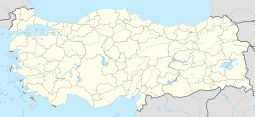Caesarea Mazaca
| Kayseri | |
|---|---|
| Metropolitan municipality | |

Top: Kadir Has Stadium, 2nd left: Sivas Avenue, 2nd right: Atatürk Statue and the city walls of Kayseri in the background, 3rd: Tekin business district and Oto Park, Bottom left: Kayseri Castle at night, Bottom right: Kayseray.
|
|
| Location of Kayseri, Turkey | |
| Coordinates: 38°44′N 35°29′E / 38.733°N 35.483°ECoordinates: 38°44′N 35°29′E / 38.733°N 35.483°E | |
| Country |
|
| Region | Central Anatolia |
| Province | Kayseri |
| Government | |
| • Mayor | Mustafa Çelik (AKP) |
| Elevation | 1,050 m (3,440 ft) |
| Population (2014) | |
| • Metropolitan municipality | 1,061,942 |
| • Metro | 1,322,376 |
| Time zone | EET (UTC+2) |
| • Summer (DST) | EEST (UTC+3) |
| Postal code | 38x xx |
| Area code(s) | (+90) 352 |
| Licence plate | 38 |
| Website |
www.kayseri.bel.tr www.kayseri.gov.tr |
Kayseri (Turkish pronunciation: [ˈkajseɾi]) is a large and industrialized city in Central Anatolia, Turkey. It is the seat of Kayseri Province. The city of Kayseri, as defined by the boundaries of Kayseri Metropolitan Municipality, is structurally composed of five metropolitan districts, the two core districts of Kocasinan and Melikgazi, and since 2004, also Hacılar, İncesu and Talas.
Kayseri is located at the foot of the extinct volcano Mount Erciyes that towers 3,916 metres (12,848 feet) over the city. The city is often cited in the first ranks among Turkey's cities that fit the definition of Anatolian Tigers.
The city is rich in historical monuments, dating especially from the Seljuk period. While it is generally visited en route to the international tourist attractions of Cappadocia, Kayseri has many visitor's attractions by its own right: Seljuk and Ottoman era monuments in and around the city center, Mount Erciyes as a trekking and alpinism center, Zamantı River as a rafting center, the historic sites of Kültepe, Ağırnas, Talas and Develi, to name a few. Kayseri is served by Erkilet International Airport and is home to Erciyes University.
...
Wikipedia

